99.9999999999% of kids draw.
Right up to and into their teen years. They may not all grow up and pursue an arts career, but they will all be drawing during their growing up years.
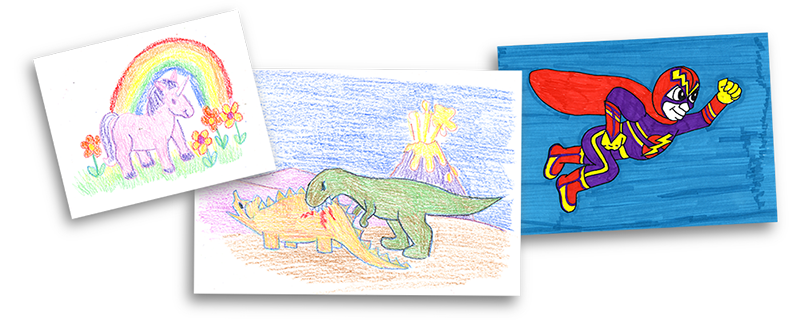
Mostly they will be drawing superheroes and comic book characters. After they tire of ponies and dinosaurs, that is.
When they get to be young adults, some of them will pursue an arts career. A few of those will become illustrators. And a portion of those will want to illustrate children's books.
Illustrating a children's book sounds like fun ... flowers and butterflies, skies full of fluffy clouds and rainbows. Teddy bears and cartoon ponies ... doesn't sound too difficult!
But eventually the day's going to come when you will have to draw PEOPLE! No problem! You've been drawing people since you were six! But maybe you've only been drawing super heroes and comic book characters.
Well, I have some good news and some bad news for you. Let's start with ...
The Good News ...
An illustrator's greatest problem is drawing scenes and figures that don't exist!
If you paint landscapes or portraits, cars or flowers, you generally have a subject or a photo of a subject that you are looking at. But as an illustrator you are drawing people and places that don't exist, totally from your imagination! You have to learn to use live models or photo references or your own knowledge of the real world as a guide to make your fantasy world and people come to life. And in some situations, there won't be any references. Hence the Grand Illusion articles where I keep emphasizing how important it is to get out in the world and observe life.
Copying and practicing drawing comic book art is an excellent way to begin to learn figure drawing! Because the stories in comic books are full of action, which means that while you are copying the art in these books, you are seeing - and learning and absorbing - the figures in all sorts of poses and perspectives. Because a human body is designed to move and respond to it's environment. And good comic book artists know how to capture all that energy in their drawings. That's what a good book illustrator does, too.
I, myself, am no comic book artist! Not by a long shot! But some of the best people-drawing tips that I want to share with you here were learned from comic-artist, Andy Smith and his book Drawing Dynamic Comics. Like I said above, there are many good things to learn from comic book art that are applicable to other kinds of illustration, including children's books. Mr. Smith actually does the opposite of what I'm doing in this article: I'm trying to tell you to use techniques from exaggerated comic art and apply it to more realistic-styled art. Mr. Smith will show you what a realistic-style figure looks like, and then show you how to exaggerate it into a comic hero! He's even got photos of real people who modeled specific poses for him so that he could draw comic book figures!
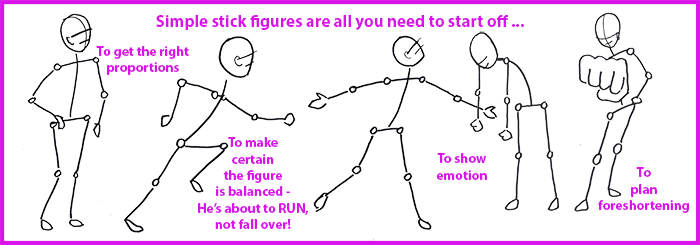
Here are some great benefits you'll get from copying comic book figures:
• The right body proportions
It's easy to draw hands and feet too small or to place facial features like eyes too high or too low on the head. Drawing these stick figures first will help you get all those proportions planned out.• Keeping action figures balanced
One of the tricks to capture action in a drawn figure is to show them suspended in the middle of a leap or running or whatever action, but you want the viewer's mind to imagine that the next action will be the leap or the running. You don't want them to look at the figure and think, Oops! That guy's about to land on his face! The trick is to not lean him out so far that he looks like he's falling, but still lean him out far enough so that you can capture the action.• Capturing and expressing emotion
When a person is happy or mad or sad, it shows on their whole body, not just their facial expression. Slumped shoulders, clenched fists, crossed arms, outstretched arms with open palms ... are all communicating in agreement with the frown, the clenched teeth, the scowl, and the big open smile!• Foreshortening and perspective
So ... you can draw an outstretched arm from the side ... can you draw that same arm, but looking down the arm from the end where the clenched fist is? Or maybe down an outstretched leg that's in the middle of a kick?
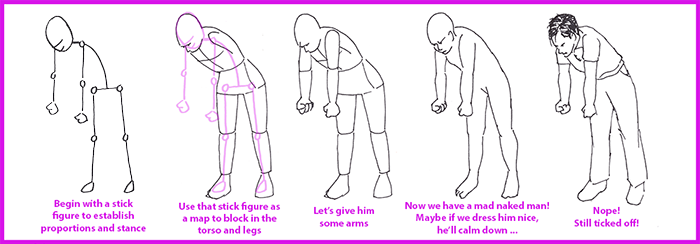
... and The Not-Really-Too-Bad News
You're mostly going to be drawing people who live in the real world, not in the comic book world! People in the real world don't look all sleek and slender with perfect proportions (at least not most of us!). That means you need to learn to translate what you learned about how those comic characters were drawn and apply it to the characters you'll be drawing for books.
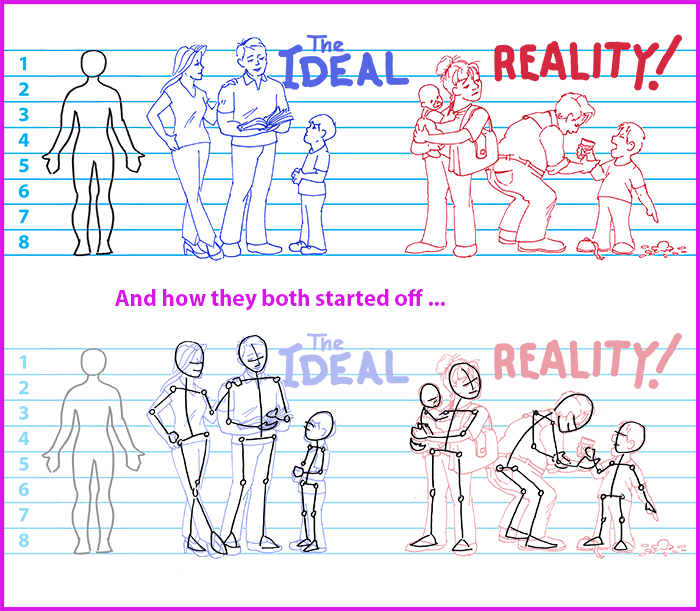
Any lady who sews knows that when she is finished sewing that new dress, it will probably turn out just fine and look good on her. But it won't quite look like that perfect little fashion sketch on the pattern envelope. The pattern companies might not sell so many patterns if they had models pictured that looked like the real us!
It's very important to have a good working knowledge of what real people are like in order to make your made-up people believable. You'll need to study real people and learn how they look and how they move. The best "fakes" are created by someone who knows what the real thing looks and acts like.
Live Sketching
Live sketching can be done anywhere there's lots of people and you can find an inconspicuous spot to sit back, observe, and make notes and sketches. Airports, parks, sidewalk cafes. If you'd like a real anatomy lesson, in warmer weather try the beach! You'll get a really good look at what some imperfect bodies look like!
My personal favorite spot is the food court at a local mall. Everybody goes to the mall and I get to see a good variety of younger and older kids, teens and adults, men and women. Along with the added advantage of having food nearby!
When live sketching don't expect to come home with pages full of beautiful, detailed drawings. Because people will be moving about and it's not going to be like sketching a model who is posing. But your quick sketches are making notes and recording what your eyes and brain are observing ... how do people move? How does their clothing sit on and move with their bodies? What do they look like when sitting, walking, standing? What kind of hairstyles do they have? How are the facial features different on different races and nationalities? If they are carrying packages, purses, backpacks, how do those relate in size and movement to their bodies?
While you are observing and sketching those quick lines, your brain and hand are storing snapshot memories of what you are observing.
When you first try this it will feel awkward and unnatural. But keep at it and over time it will begin to feel more natural. The actual sketching you do will be like taking notes while listening to a talk. Later, back in the studio, those notes will jog your memory and you will find you have a rich resource to pull from when you need reference material.
Sometimes people will notice what you're doing and show an interest. By all means share with them what you're doing and show them your sketches. You don't want to call attention to yourself, but when you are noticed, be open and approachable. You will find that people enjoy watching you draw.
Take care when taking photos. I use my phone camera to get shots of landscapes, crowd shots and surroundings for reference when back in my studio. And phone shots are okay if you are far enough away from people to get reference photos of clothing, hair styles and body positions. But get permission from people before taking up-close photos, especially of children. And never, never publish these photos or do realistic, recognizable drawings of actual indiviuals. Forget the legal ramifications, just don't be rude and creep people out! Be self-aware and conscious and courteous to others around you.
But far better than any camera, is a pencil in your hand, all sharpened and ready to go. Keep a small sketch book handy whenever you go out. Over time you will see how valuable it is. One day you'll be needing some ideas for characters in a book, and your brain will go blank. So you'll whip out that sketchbook you've been filling up for a few months to see if you can find some ideas. And you will marvel at how much variety there is among human beings ... and you won't be drawing perfect versions of superheroes or anatomically perfect specimens any more ... instead you'll have a rich selection of ...
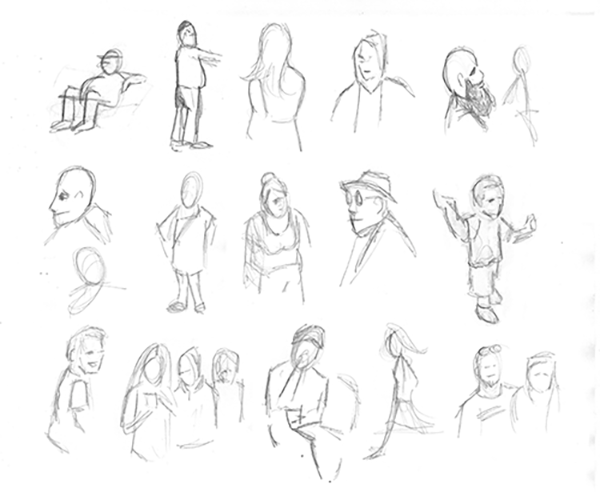 • People with big bellies
• People with big bellies • People with no butt
• Beautiful people
• Scroungy people
• People who don't know which side of their head their hair should be on
• People with no hair at all
• Poor people who can't afford mirrors at their house!
• People who are old and wise
• People who are at the beginning
• People who travel in herds
• And the loners
• And the lovers